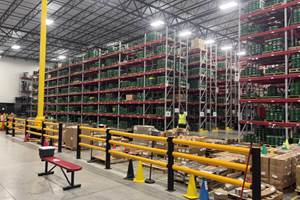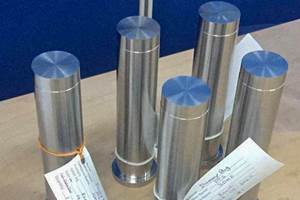Think Tank, US Navy Announce Plans for Developing Guam Additive Materials and Manufacturing Accelerator
Nonprofit organization ASTRO America will manage staging and deployment of 3D Printing Technology and Workforce Education Center on Guam to diversify the island’s economy and support Indo-Pacific submarine industrial base needs.
The Applied Science & Technology Research Organization of America (ASTRO) has issued an implementation plan to build the Guam Additive Materials & Manufacturing Accelerator (GAMMA). The project is the culmination of efforts to bring industrial additive manufacturing (AM) or 3D printing to the island in order to diversify and expand Guam’s economy.
Guam Governor Lourdes A. Leon Guerrero and her administration commissioned a study by ASTRO America, a manufacturing policy think tank, to evaluate the feasibility of bringing such technology to Guam. A strong advocate for modernizing submarine production and addressing material readiness challenges through advanced technology, U.S. Navy Rear Admiral Scott Pappano, program executive officer, Strategic Submarines (PEO SSBN), and his team are partnering to help implement and scale innovative solutions to modernize America’s submarine industrial base.
The center will be based on three pillars — workforce development and education; component testing and evaluation; and manufacturing business incubation/support on-island.
A corresponding report was developed at the direction of the Guam Bureau of Statistics and Plans (BSP), following ASTRO’s previous feasibility analysis undertaken for the Guam Economic Development Authority. Overall, it reflects an initiative by Governor Leon Guerrero over the last two years to evaluate the potential for industrial AM to advance economic growth in Guam.
“I strongly believe GAMMA can revolutionize Guam’s economy and establish the island as a part manufacturing hub in the Indo-Pacific region,” says ASTRO President Neal Orringer. “ASTRO America stands committed to helping realize Governor Leon Guerrero’s vision, and chart a course for the island’s future in on-demand production.”
The report stresses that GAMMA’s two principal goals should be (1) promoting U.S. national security and (2) helping diversify the economy, in partnership with the federal government. In particular, Guam offers an opportunity to support the readiness and resilience of key American and Allied submarine supply chains.
Accordingly, the project plan would establish GAMMA as a proponent of the U.S. Navy’s Program Executive Office Strategic Submarines (PEO SSBN), which is responsible for U.S. strategic submarines’ life cycle management as well as advancing submarine industrial base health. GAMMA will thus help drive development of submarine industrial base capabilities in the Indo-Pacific, supporting the needs of the United States as well as UK and Australia, in sustaining a technological edge in submarine construction, particularly relative to the military’s peer competitors in the region.
The report expounds on the project plan jointly announced by Guerrero and Pappano in February 2024.
At the outset, the U.S. Navy will serve as the primary customer and funding source for GAMMA, which will encompass a site for workforce training and education, naval ships’ part testing and evaluation, as well as prototyping and supply chain maturation. New infrastructure will provide high-caliber training and cutting-edge production capabilities on-island that, over the long term, may also be applied to a broad range of commercial (non-naval) industries across the Indo-Pacific.
The cornerstone of GAMMA is a satellite campus of a mainland U.S. university in Guam, based on the grounds of the University of Guam. ASTRO is helping the University of Guam and Guam Community College enter an agreement with another academic institution renowned for its leadership in manufacturing education and technical research. This partnership will support conferring of joint certifications as well as associate’s, bachelor’s and master’s degrees for students on-island from UOG, GCC and the mainland U.S institution.
Additionally, ASTRO will also support establishment of the only industrial metallic part inspection and validation laboratory within thousands of miles. The plan calls for a GEDA-sponsored facility to be built on-campus to house operations supporting each of the three pillars.
“For two years, ASTRO, commissioned by GEDA and BSP, has grown a body of expertise on developing industrial AM capabilities in Guam,” Leon Guerrero says. “As we move toward making GAMMA a reality, we will continue to work with our partners to diversify Guam’s economy and establish the island as a center of excellence for additive manufacturing, particularly for the United States Navy’s submarine force. I am pleased that so much of our island’s talent and expertise is being utilized to create new job opportunities for Guam and contribute to America’s national security interests.”
Next Steps for the Implementation Plan include activities sponsored by PEO SSBN in concert with another nonprofit organization supporting the Navy, Blue Forge Alliance:
- Enrollment of five Guam students to the U.S. Navy’s Accelerated Training in Defense Manufacturing in Danville, Virginia
- Education Workshop at the Colorado School of Mines (Mines) with participants from UOG, GCC, GEDA and Mines administration as well as ASTRO and Navy personnel
- Technical Workshop in Washington, D.C., with key U.S. Navy and shipbuilder decision-makers
- Guam Workshop – fall 2024
ASTRO America is a not-for-profit, nonpartisan research institute and think tank. It was established in 2018 to advance the public interest through manufacturing technology and policy. Led by manufacturing professionals with broad public and private sector experience, ASTRO America supports collaborations by government agencies and companies to address supply chain challenges in highly regulated industries, including aerospace and defense.
Related Content
How Machining Makes AM Successful for Innovative 3D Manufacturing
Connections between metal 3D printing and CNC machining serve the Indiana manufacturer in many ways. One connection is customer conversations that resemble a machining job shop. Here is a look at a small company that has advanced quickly to become a thriving additive manufacturing part producer.
Read MoreDo Distributors Dream of Digital Inventory? Würth Additive Group Does
It’s more than a dream for Würth Additive Group and its parent company, in fact. Along with supplying additive equipment, the group is now developing solutions for sourcing 3D printed parts in a reliable, elastic digital inventory model.
Read MoreConocoPhillips Sees Oil and Gas Supply Chain Opportunity With Additive Manufacturing
Production of parts when needed and where needed can respond to the oil and gas sector’s multibillion-dollar challenge of holding parts in inventory. The supply chain benefit will justify additive even before the design freedoms are explored.
Read MoreThis Year I Have Seen a Lot of AM for the Military — What Is Going On?
Audience members have similar questions. What is the Department of Defense’s interest in making hardware via 3D printing over conventional methods? Here are three manufacturing concerns that are particular to the military.
Read MoreRead Next
Alquist 3D Looks Toward a Carbon-Sequestering Future with 3D Printed Infrastructure
The Colorado startup aims to reduce the carbon footprint of new buildings, homes and city infrastructure with robotic 3D printing and a specialized geopolymer material.
Read More3D Printed Polymer EOAT Increases Safety of Cobots
Contract manufacturer Anubis 3D applies polymer 3D printing processes to manufacture cobot tooling that is lightweight, smooth and safer for human interaction.
Read MoreBike Manufacturer Uses Additive Manufacturing to Create Lighter, More Complex, Customized Parts
Titanium bike frame manufacturer Hanglun Technology mixes precision casting with 3D printing to create bikes that offer increased speed and reduced turbulence during long-distance rides, offering a smoother, faster and more efficient cycling experience.
Read More






















